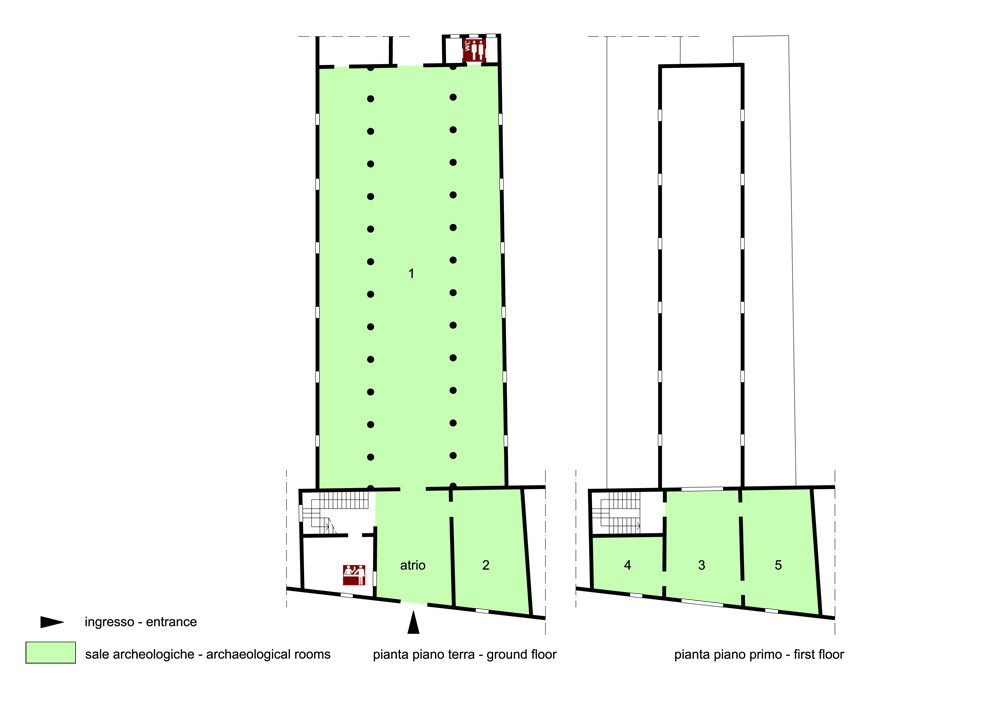| Via del Seminario 26 - 30026 Portogruaro (VE)
Tel. 0421 72674 - Fax 0421 72674 |
|
|
Summary
The building has two floors. On the ground floor there is a hall and a large room with three aisles (basilica). This floor hosts architectural exhibits, funeral stele, portrays and epigraphic material arranged according to the antique standards of the 1800s. On the floor along the central nave there are three mosaic pavements, two with geometrical motives and the third with The Three Graces.
The adjacent room, on the right hand side from the entrance houses decorative elements from public and private living areas of Concordia as well as coins found in Concordia’s countryside. On the first floor the displays hold the materials found by local collectors and by Dario Bertolini in his excavation works at the end of the 19th century. These are artefacts from the pre-Roman and Roman times of the city, such us some bronze figures. Further down there are some fragile exhibits divided in groups: glass, stones, amber adornments, lamps and other every day use objects. Finally there is a collection of various objects found during excavation works in Consordia Sagittaria
Collection history
The core of the Museum was founded at the end of 1700’s by the materials provided by Muschietti, a family of local collectors. The collection was then passed, in line with their last will, to Comune of Portogruaro (second half of the 19th century) and was temporarily kept in the Town Hall. At the end of the 19th century, as more material was found during excavation works in the urban area and the ‘military cemetery’ of Concordia Sagittaria the need for an appropriate building that could contain all the collections was becoming extremely pressing. Thanks to the initiative and persistence of Dario Bertolini and Giuseppe Giorelli, then Head of the exploration works, the Municipality purchases land in via Seminario and the Ministry financed the construction of Concordia Museum. The milestone was set in 1885 and the Museum was opened on the 28th of October 1888. It was completely renovated and re-opened in 1986. The renovated objects are presented in display cabinets whereas the stone findings were kept in their original set up, perfectly illustrating the collecting methods in those days.
|
 |
|
Visiting
Admission: Negli orari di apertura;
Ticket: Si;
Price: Full price € 3; reduced price € 1,5; free entrance for under 18 and over 65;
 School access School access
 Disabled access
Limited to the firs floor Disabled access
Limited to the firs floor
|
Recommended tour time (minutes): 60 |
|
Services for visitors
 Toilet Toilet |
Educational Services
 Guide a stampa
Audio guide Guide a stampa
Audio guide Information boards Information boards Captions under exhibits Captions under exhibits Multilingual ads: Francese
Tedesco
Inglese Multilingual ads: Francese
Tedesco
IngleseLeaflets  Guided Tours Guided Tours For any information, please cal tel. 0421 72674.  Educational activities Educational activitiesTeaching courses offered by the association "Studio D Friuli" (Francesca Benvegnù tel. 3463257139; e-mail: studiodfriuli@alice.it).  Library and documentation centre Library and documentation centreLibrary and historical archive |
Bibliography
| Broilo F. 1980, Le iscrizioni lapidarie latine del Museo Concordiese di Portogruaro, I, Treviso. |
| Broilo F. 1983, Le iscrizioni lapidarie latine del Museo Concordiese di Portogruaro, II, Roma. |
| Larese A. 1983, Le lucerne fittili del Museo Concordiese di Portogruaro, Roma. |
| Lettich G. 1983, Le iscrizioni sepolcrali tardoantiche di Concordia, Trieste. |
| Croce Da Villa P. 2001, Il Museo Nazionale Concordiese di Portogruaro e le aree archeologiche di Concordia Sagittaria, Concordia Sagittaria. |
| Pettenò E., Toso S. 2006, A proposito delle gemme “incise a perfezione” del Museo Nazionale Concordiese di Portogruaro, in Quaderni di Archeologia del Veneto, XXII, pp. 199-211. |
| Pettenò E. 2007, La colonia di Iulia Concordia e la “collezione” del Museo Nazionale Concordiese di Portogruaro, in Vasa Rubra. Marchi di fabbrica sulle terre sigillate di Iulia Concordia, a cura di Pettenò E., Padova. |
| Pettenò E., Marano L. 2008, Un contributo per la storia del Museo Nazionale Concordiese di Portogruaro: la revisione degli Inventari relativa alla collezione storica, in Quaderni di Archeologia del Veneto, XXIV, pp. 226-230. |
| Pettenò E. 2008, Capitello di lesena, in Restituzioni. Tesori d’arte restaurati, Catalogo della mostra (Vicenza, 29 marzo – 29 giugno 2008), Venezia, pp. 62-65. |
| Pettenò E. 2008, Cinque vetri da Concordia Sagittaria, in Restituzioni. Tesori d’arte restaurati, Catalogo della mostra (Vicenza, 29 marzo – 29 giugno 2008), Venezia, pp. 70-73. |
| Pettenò E. 2008, Statuetta di Diana cacciatrice, in Restituzioni. Tesori d’arte restaurati, Catalogo della mostra (Vicenza, 29 marzo – 29 giugno 2008), Venezia, pp. 82-85. |
| Bonetto J. 2009, Veneto (Archeologia delle Regioni d'Italia), Roma, pp. 438-441. |
| Incise a perfezione. La collezione glittica del Museo Concordiese 2009, a cura di Pettenò E., Padova. |
| Pettenò E. 2009, La “Madonna in trono con Bambino di Portogruaro”. Memoria dell’antico al Museo Nazionale Concordiese, in Annali della Scuola Normale Superiore di Pisa. Classe di Lettere e Filosofia, s. 5, 1, pp. 165-188. |
| Di Filippo Balestrazzi E. 2012, Sculture romane del Museo Nazionale Concordiese di Portogruaro, Roma. |